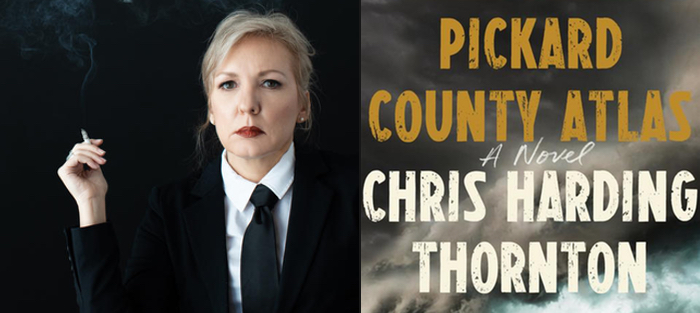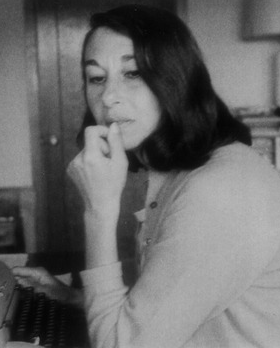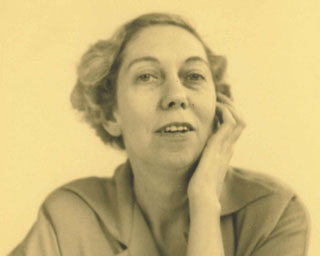Many times, while driving between my physical home in South Dakota and my spiritual home in Colorado, I’ve found myself wondering about the lives of people in central and western Nebraska, away from the urban centers of Omaha and Lincoln. There, abandoned buildings of all vintages dot the landscape. Houses, farms, old gas stations, shelters for long dead cattle. There, sparseness is as much a way of life as the agricultural seasons.
Chris Harding Thornton’s debut novel, Pickard County Atlas (MCD Books/FSG), invites us into that world. Set in the late 1970s, with gas prices skyrocketing and middle America’s agricultural economy tanking, the novel centers on the slow dissolution of the Reddick family. The eldest son, Dell Jr., was murdered almost two decades ago, but his body was never officially found. This fact vexes not only the family but the entire community of Madson, Nebraska, and especially police officer Harley Jensen, who is as haunted by the failure to find Dell Jr. as he is by his own ghosts. The two remaining Reddick sons, Paul and Rick, spiral around their family’s fractured history and draw Harley into an escalating, destructive conflict.
The novel is a unique accomplishment in that it’s highly atmospheric without spending a great deal of energy establishing its atmosphere. There are no page-long descriptions of the abandoned homes in the middle of nowhere that Jensen regularly visits on his policing rounds, but I could smell the wood in them—rotting from moisture in some spots, baked to dry oblivion by the sun in others. The intense presence of Pickard County Atlas is a testament to a writer deeply in touch with her landscape who doesn’t have to think about it to render it. Thornton creates a world thick with the tendrils between people, places, and ghosts that keeps delivering layer after layer of revelation.
Pickard County Atlas was released in the first week of 2021, making Thornton the only writer I know to launch her debut novel in the midst of a pandemic and a coup attempt.
Interview:
Steven Wingate: Atlas is described as a rural noir, and it reads like one. What drew you to the genre, and do you feel like it’s a home for you?
Chris Harding Thornton: This question kept me up all night. It did. I was awake thinking, “What makes something noir?” I ran through the caricaturized version of the PI and the dame and the double cross, but noir is bigger than that, of course. I’ve seen Fritz Lang’s M called noir. If I can ever write something like M, people can call it whatever—I’ll be happy.
There are elements of this novel that do fit noir. Noir generally has an investigator (journalist, detective, cop), a lot of deception, and some moral gray areas. Harley’s a sheriff’s deputy, even if he’s less “hardboiled” than reluctant and damaged. And deception—inadvertent and intentional—drives the story. The book wrestles with a few moral questions some people will find troubling, too. So, I see where all that fits. But deception and moral complexity drive comedy and tragedy in general. They’re in most stories I like.
To cut to the chase and come clean: I didn’t write noir on purpose. But you know, I read the book and see themes others won’t (and vice versa). Different interpretations apply to genre, too. Some will think the book is noir. I think of it as maybe “literary,” but that word is a can of worms. All that said, the next one has a private detective in it.
In the bigger picture, who were some of the writers—both inside and outside the noir tradition—who shaped your identity?
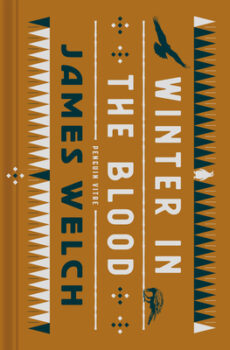 I think the short answer is that, because writing gives people experiences, I’ve been shaped by everything I’ve read, and I’m not totally sure I have an identity. But I’ll spare you that whole spiel.
I think the short answer is that, because writing gives people experiences, I’ve been shaped by everything I’ve read, and I’m not totally sure I have an identity. But I’ll spare you that whole spiel.
Most of my favorites look like a reading list for a high school or undergrad course. Shakespeare’s Iago made me shape the character Paul Reddick the way I did, and I have favorites by Ellison, Vonnegut, Joyce, Baldwin, Beckett, Carver, Bambara, Ford, Melville, Mason, Oates, Hemingway, McCarthy, Mukherjee. Oh—and Cheever—specifically “The Death of Justina.” I could read that story every day. That and one paragraph in Faulkner’s “Barn Burning.”
A more out-of-the-way writer I love is Wright Morris, who set a lot of novels in Nebraska. Not many people know about him now, but he won two National Book Awards in his day. My favorites are the ones the critics didn’t like: The Home Place, Ceremony in Lone Tree, The World in the Attic, and The Man Who Was There. James Welch’s Winter in the Blood isn’t obscure, but I want to put that in here because I think everyone should read it. That book wrecks me like nothing else.
The novel is set in the late 1970s. Why is that era resonant now, not only for you but for America in general?
Well, I can’t speak for America, but how I experienced the time and how I frame it today is a mix. The wealth divide wasn’t as lopsided as it is now, but a lot of people were scraping by, and gas shortages and inflation didn’t help. Employers still gave pensions for the right jobs, but a lot of people didn’t have those jobs. Labor laws were better than they are now. But then, small farming was about to collapse. It felt like a crumbling cliff.
Culturally, when I think “1970s,” I think of Dog Day Afternoon, Good Times (which went haywire but started strong), All in the Family, and Electric Company. It felt like a minute when unfiltered discussion and diversity were just normal. Then came a backlash, people voted with their wallets, and we had the Reagan administration, which is now considered moderate. I don’t really remember it that way. I remember Farm Aid, “trickle-down economy,” a war on drugs that was okay with coke but not crank or crack, a lot of people dying of AIDS, and an everyday fear of getting nuked.
I guess I hope the resonance can be that a lot of things that have been reversed can be reversed again, for better or worse. History is made of reactions to reactions. It isn’t inherently going in a good direction. I have a weird thing against analogies, but if you’re driving a car and the fan belt breaks, a windshield wiper falls off, and a pothole blows a tire and bends the rim, you don’t say, “Well, I’ll keep driving like this—only car I have.” But you don’t push the car off a cliff, either.
First novels often take a long time to “cook,” though that’s not always the case. How long did Pickard County Atlas take from germination to fruition?
The first bit came to me back in 2008. I was teaching and going to school in Seattle. I sat down to write and heard a desperate, angry voice in my head. I wrote it down, not sure where it was going. I moved back to Nebraska for more school, and now and again, chunks of writing that were vaguely related to the first one materialized in time for workshops. They were mainly sketches of characters and settings. Then, I took a few years away from the book to write a dissertation. That involved researching the history of agriculture, railroads, and small towns in Nebraska, plus a thirteen-day walk for two hundred miles on the state’s Cowboy Trail.
When I came back to this book, I used spring and winter breaks, a semester when I had a course reduction, and maybe a summer. Revisions took about eight days, but the first copy edit took longer. As a ballpark figure, I think the book took about two years to write, spread over twelve.
Along that path, what were some of the major milestones for you? (Like a change in voice, a realization about your characters or setting, etc.)
The first milestone was that 2008 chunk, which turned out to be the character Pam Reddick (most of that first burst is in chapter eleven), and the second milestone was the walk into the sandhills, which did a lot for setting. Another major milestone was during a workshop at University of Nebraska, when a writer named Kate Kostelnik pointed out that a character’s action in a scene—he killed a snake—was more symbolism than plot point. What would happen because he did that? Nothing.
I’d taken a lot of writing workshops by then, for a BFA and an MFA. Workshops often focus on short stories because of class sizes and time constraints, and in short stories, sometimes writers can pull off a quiet, symbolic action as a climax. I hadn’t really learned how to work with a novel-sized plot. But after Kate said that, I was obsessed with the idea that every moment needed to cause something else. Every object turned into “Chekhov’s gun.” Buckets were guns. Newspapers were guns. If an ashtray in the first chapter didn’t go off in the second or third, I tried to nix it. Then, when I revised, I saw I’d planted objects and lines of dialogue everywhere that were clues to plot—like the little teeth of cogs. I needed to align and turn them.
Pickard County Atlas moves forward through time using alternating (and interlocking) perspectives. It reminded me of my favorite Faulkner novel, As I Lay Dying. How did you find your way to this strategy, and was it challenging in rewrite at all? I kept thinking how hard it would be to keep track of who knows what and when.
I found the strategy through instinctual fear of any other option. I’d written in first person when I started writing stories, and that was uncomfortable. One semester at UW, I decided I’d write only in third limited—no peeking into anybody’s heads or bodies at all. I did it because it made me show things, not have everything be so internal. The result wasn’t good, but I think I needed to do it, to find balance. In Pickard County Atlas, that balance wound up being third limited-omniscient with a revolving close focus on three characters, which was fun—being in one character’s head and seeing another character (whose head we’ve been in) from the outside. Third person was also a constant reminder to myself that, yeah, I’m developing a world and there are motifs and underlying themes and all that, but my job is to tell a story. Spin a yarn.
Keeping track of who knew what and when wasn’t hard—probably because that’s what drives the plot, each character not knowing what the others know. What I did make a mess of during one of the revisions was the timeline, so thank goodness for copy editors.
You dig into a quite broad cast of characters in the novel. Which did you write most freely, and which did you struggle with? Is there a common denominator for either group?
So many characters! I’ve never counted them—and the ones mentioned and never seen do count. There are towns in Nebraska with fewer people than there are in the book, which isn’t long. I worried about that and had friends read it. When they didn’t seem confused, I left everybody in.
The things that came easily were characters’ voices, what they did for a living, how they spent their time, and their personal histories. Embedded in all that was whatever each character wanted. That was a struggle with two characters, but once I figured them out, I knew what each character’s story was. They’d all try to get what they wanted, and they’d get it or wouldn’t.
The thing I struggled with most was Robert Frost in the back of my head, screaming, “no tears in the writer, no tears in the reader!” I was fine when characters made me laugh (and they did, a lot). When they had rage, paranoia, lust, fear—all that was fine. But did I want a large helping of vulnerability, sadness, regret, or devastating catharsis? I’d rather pass on those, thanks. Six characters needed them, though, usually at their endings. I took each one at a time, in separate revisions, least painful to most painful, instead of the order they appear in the book.
One of the things that intrigued me most about the novel is the way you don’t use physical description much to render your setting. Sure, there are barns, but you don’t linger on them. It felt instead that you were building up a setting—not merely a physical one but a psycho-social one—by drawing lines between people living and dead. Can you talk a bit about how people create a setting?
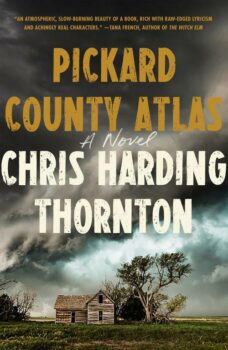 That’s really interesting—and another thing I didn’t do intentionally. But a couple of writers who grew up in Nebraska and used it for a lot of settings, John Neihardt and Wright Morris, both did something that sounds really similar. Narrators in more than one Wright Morris book say, “the plain is a metaphysical landscape.” And in writing about the use of settings in Neihardt’s work, Vine Deloria, Jr. noticed that people and place are so tied to each other that “one becomes the other in a metaphysical sense.” That concept isn’t exclusive to Nebraska, but maybe a lot of the landscapes here are so easy to internalize that a division between person and place isn’t really clear.
That’s really interesting—and another thing I didn’t do intentionally. But a couple of writers who grew up in Nebraska and used it for a lot of settings, John Neihardt and Wright Morris, both did something that sounds really similar. Narrators in more than one Wright Morris book say, “the plain is a metaphysical landscape.” And in writing about the use of settings in Neihardt’s work, Vine Deloria, Jr. noticed that people and place are so tied to each other that “one becomes the other in a metaphysical sense.” That concept isn’t exclusive to Nebraska, but maybe a lot of the landscapes here are so easy to internalize that a division between person and place isn’t really clear.
The lines you mention, between people who are living and dead, are interesting to think about, too. If you mean the characters draw lines between themselves and the dead—like to separate themselves from the dead—I think that’s probably knee-jerk self-preservation. A shut-off valve for grief or maybe fear of dying. But if you mean the characters draw lines connecting themselves with the dead, I suspect that’s because when we lose people to death, we also kind of don’t. Or at least that’s my experience—those people are still present in my daily life and in everything I do and am.
You’ve had a career in independent music. Can you talk about about how has this shaped your approach to your fiction—both creatively and in marketing.
Creatively, music’s biggest impact is attention to sound—mainly rhythm. A sentence always needs a certain number of syllables in it. And my characters have soundtracks. If I need to get into a character’s head, I listen to an album or a song they do. The last two revisions of the book, I bet I listened to Led Zeppelin’s cover of “When the Levee Breaks” for about twelve hours.
In independent music, there was also a lot of collective effort in putting on shows and making or selling records. I think that turned me into a cheerleader of others’ work. I also think spending years around people who were writing music and doing visual art made writing a book seem less ridiculous. I think what we assume is possible is shaped by what we see. I suspect people who go into politics—not all, but a lot—grow up in a bubble where being a politician is just a thing people do. I was in a bubble where people made creative things, so doing that myself felt normal.
Marketing-wise, writing artist bios and one-sheets (press releases for records) helped me write a query letter. And then volunteering at an all-ages club, coercing people into seeing bands in subzero temperatures (in a venue where you couldn’t drink) took some hustle. But I also learned there’s a lot to be said for letting things happen. There’s a way to balance hustle with stepping back and letting the record or book do its thing. Sometimes that thing takes a while.
Your publisher, MCD, is known as something of an experiment and has been described as “a lab for what’s possible at Farrar, Straus and Giroux.” Can you talk a bit about the MCD x FSG experience and what it means to you to debut here?
The experience has been surreal and great. They’ve released incredible and really varied stuff. You don’t see MCD x FSG on a book spine and say, “Okay, this will be ____.” You’ve got a Nebula Award Winner with Jeff VanderMeer, then Maria Dahvana Headley’s translation of Beowulf (which is the only version of Beowulf I’ve read voluntarily), and then Kobe Bryant. I mean: Kobe Bryant. That’s incredible.
At first, I wasn’t sure how I fit into that lab for what’s possible at FSG, but it makes sense now. I think I wrote a book about people who might not normally have books written about them. And look at the contortions I went through in answering the question about noir. Is it noir? Is it psychological suspense? Is it an extremely dark comedy of errors? Probably yes, yes, and yes.

